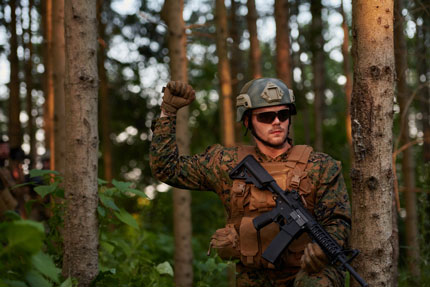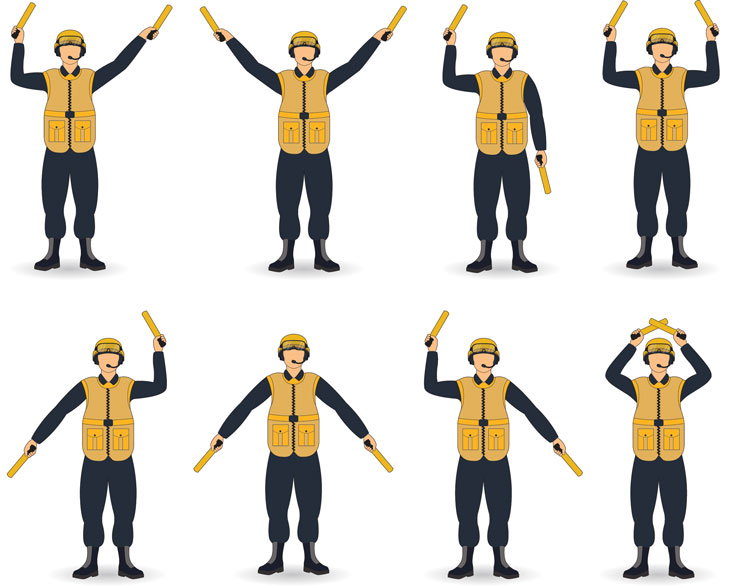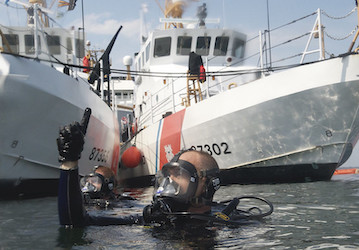Clear, accurate, and secure communication is vital for efficient operations and optimal mission performance. But it’s not always as straightforward as shouting a command or simply talking with those around you. Combat conditions can often limit how well your team communicates verbally. Arm and hand signals, gestures, and even touch signs have become a standard part of communication in the military, especially when voice communication is difficult, impossible, or you have to maintain silence for security or operational purposes.
Visual signals require sight lines and can be used to share basic messages quickly over short distances. In addition to arm and hand signals, Service Members can use flags, wands, smoke, and light to communicate. But using these forms of communication isn’t always easy, especially when there’s a lot going on around you. The good news is, with some basic strategies, you can optimize your ability to complete this core communication task.
Gestures in language
People typically use a combination of words and gestures to share information. In fact, the saying “actions speak louder than words” is pretty accurate. About 65–70% of a message’s meaning comes from nonverbal cues, while only 30–35% comes from verbal language.
For example, there are signals you might use while you speak, such as holding your hands apart to describe something big. And there are signs that might replace some element of verbal communications, such as giving a thumbs-up.
The dozens of different visual signals Service Members use are actually quite unique—and they can communicate important information and instructions. Before entering a situation where you know you might encounter a large amount of stimuli, review your communication signals, practice mindful breathing, and trust yourself and what you know.
Visual signals in the military
 Service Members typically use military arm or hand signals to communicate when they can’t speak—in person, by radio, or by phone—due to distance, safety, or security reasons during drills or in theater. On the plus side, these signals are tried-and-true. They can quickly convey crucial information, such as directional commands or details about locations, often without extra equipment. For example, the balled fist signal is a quick way to communicate “freeze” or “stop.”
Service Members typically use military arm or hand signals to communicate when they can’t speak—in person, by radio, or by phone—due to distance, safety, or security reasons during drills or in theater. On the plus side, these signals are tried-and-true. They can quickly convey crucial information, such as directional commands or details about locations, often without extra equipment. For example, the balled fist signal is a quick way to communicate “freeze” or “stop.”  Some visual signals do require additional equipment, such as the wand used to guide aircraft during takeoff and landing.
Some visual signals do require additional equipment, such as the wand used to guide aircraft during takeoff and landing.
But like any mode of communication, there are challenges. For example, visual signals can be limited in areas of poor visibility from bad weather, sand storms, or smoke. Visibility can be limited by trees, heavy foliage, and buildings that block sight lines too. Communication can also be interrupted by lag times between units trying to coordinate their messages (for example, “halt”).
One of the biggest challenges for Service Members is sensory overload. Especially in combat conditions, warriors need to maintain situational awareness, monitor what’s going on around them, complete their tasks, and try to maintain focus on visual (and sometimes audio) communication—all at the same time. The reality is, these situations are often accompanied by fear, stress, and other feelings that can get in the way of communication.
Strategies for success
It’s not easy to perform under extreme stress while you take in large amounts of information, make decisions, and maintain safety for yourself and those around you. But with a few strategies, you can boost your ability to stay focused, process, and recall the communication signals needed for mission success.
- Let stress work for you. Your body automatically reacts to stress or sensory overload with a response designed to keep you safe. For example, your heart rate might increase or you might get tunnel vision, shake, or sweat. While these physical reactions might seem unpleasant or feel like panic or anxiety, they can help you focus and react under pressure—if you let them.
- Activate your working memory. Your working memory is the brain system that controls, regulates, and uses specific information that you need immediately for a particular task. In this case, it might be your working memory of how to interpret and use visual communication signals. Under stress or in moments of anxiety, your working memory is taxed and you might not be able to solve problems as you normally would. To overcome that, slow down, do what you’ve practiced, and avoid shortcuts.
- Trust your training. Your best asset to maintain focus during high-stress situations is to let your mind and body do what it’s been trained to do. Devote enough training time to learning your signals, so they become second nature. And before you enter a situation where you expect you’ll encounter a large amount of stimuli, review your communication signals, practice mindful breathing, and trust what you know.
- Use emotional regulation. Controlling how you react is a major part of staying focused under stress. You might not be able to change your stress response, feelings of fear, or experience of being overwhelmed, but you can control how you react. If you feel panicked or overwhelmed, try mentally repeating a grounding phrase (for example, “shoot-move-communicate”) to distract yourself from spiraling into paralyzing emotions. Stay focused on processing the information around you.
What’s ahead: Tactile communication
While visual signals have proven effective for years, there are still limitations. In recent years, “tactile signals” have been explored as another way for Service Members to communicate. Tactile signals are a way to present information through touch and through the skin, such as when you feel your cell phone vibrate. Or think about how a horseback rider cues their animal to move by pulling on the reigns or pushing their feet against the horse. In the future, it could be possible to send similar touch communications using special clothing, gear, or helmets. Such tactile signals need to be improved before they can be useful in combat situations. But they offer promise to improve survivability and information flow, and to achieve the mission in hands- and eyes-free ways, especially when visibility is a problem.
